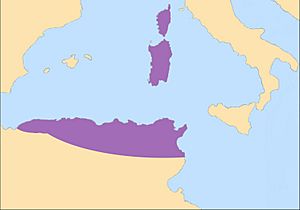Battle of Tricamarum facts for kids
Quick facts for kids Battle of Tricamarum |
|||||||
|---|---|---|---|---|---|---|---|
| Part of the Vandalic War | |||||||
 Battle of Tricamarum |
|||||||
|
|||||||
| Belligerents | |||||||
| Byzantine Empire | Vandal Kingdom | ||||||
| Commanders and leaders | |||||||
| Belisarius John the Armenian Calonymus |
Gelimer | ||||||
| Strength | |||||||
| 8,000 | 15,000 | ||||||
| Casualties and losses | |||||||
| 50 | 800 | ||||||
The Battle of Tricamarum was a major battle that happened on December 15, 533. It was fought between the armies of the Byzantine Empire and the Vandal Kingdom. The Byzantine army was led by a famous general named Belisarius. The Vandal army was commanded by their king, Gelimer, and his brother, Tzazon.
This battle took place after the Byzantines had already won an important fight called the Battle of Ad Decimum. The victory at Tricamarum completely ended the power of the Vandals. It also finished the Byzantine Emperor Justinian I's plan to take back North Africa. Most of what we know about this battle comes from a historian named Procopius. He wrote about it in his book Wars of Justinian.
Contents
Preparing for Battle: What Happened Before Tricamarum?
After their big win at the Battle of Ad Decimum, General Belisarius and his army took control of the city of Carthage. The Vandal king, Gelimer, moved his forces to a place called Bulla Regia in Numidia. This was about 150 kilometers (93 miles) west of Carthage, near where modern Tunisia is today.
Gelimer knew his army was not strong enough to fight Belisarius right away. So, he sent messages to his brother Tzazon, who was away fighting in Sardinia. Tzazon quickly returned to Africa to join Gelimer.
Gelimer's Plan to Weaken the Byzantines
While waiting for Tzazon, Gelimer tried to cause trouble for Belisarius. He offered rewards to local Berber tribes for every Byzantine soldier they could capture. He also sent secret agents into Carthage. These agents tried to convince the Byzantine Hun mercenaries to switch sides. The Huns were very important to Belisarius's victory at Ad Decimum.
Tzazon and his army finally met up with Gelimer in early December. With his brother's help, Gelimer felt his army was strong enough to attack. As they marched towards Carthage, the Vandal army stopped to destroy a large aqueduct. This aqueduct was important because it supplied most of Carthage's water.
Belisarius had spent twelve weeks making Carthage stronger since the last battle. But he knew about Gelimer's secret agents. He also worried that the Huns in his army might betray him. Instead of waiting for a possible attack while trapped in the city, Belisarius decided to march out. He put his cavalry (soldiers on horseback) at the front, the main Byzantine army in the middle, and the Huns at the very back.
The Battle of Tricamarum: A Fierce Fight
The two armies met at Tricamarum, which was about 50 kilometers (31 miles) west of Carthage. The Byzantine cavalry immediately charged forward, attacking the Vandal lines. They regrouped and charged two more times.
Then, the Byzantine infantry (foot soldiers) fiercely attacked the Vandal infantry. The Byzantines quickly gained the upper hand. During the third charge by the Byzantine cavalry, Tzazon, King Gelimer's brother, was killed. Gelimer saw his brother fall. Just like what happened at Ad Decimum, Gelimer lost his courage.
The Vandal army began to fall back, and soon they were running away in a complete retreat. Gelimer fled back into Numidia with the soldiers who were left. The Vandals had lost about 800 men in the battle. After his victory, Belisarius marched to the city of Hippo Regius, which opened its gates and surrendered to him.
After the Battle: The End of the Vandal Kingdom
Gelimer soon realized that his kingdom was lost forever. He tried to escape to Spain, where some Vandals still lived. However, the Byzantines found out about his plan and stopped him. Gelimer had to leave all his belongings behind and hide in the mountains of Tunis with the Berbers.
The next year, Roman forces led by a commander named Pharas the Herulian found Gelimer and surrounded him. At first, Gelimer refused to give up, even when he was promised good treatment. But after a very harsh winter, he finally surrendered to Belisarius. This surrender marked the official end of the Vandal Kingdom. Their lands in Sardinia, Corsica, and the Balearic Islands also came under the control of Emperor Justinian.
Why Was This Battle Important?
Historian Paul K. Davis explains that with this victory, the Byzantines took back control of North Africa for the Eastern Roman Empire. This area then became a starting point for the Byzantine army to invade Italy. This invasion, for a short time, brought the Eastern and Western Roman Empires back together.
See also
 In Spanish: Batalla de Tricamerón para niños
In Spanish: Batalla de Tricamerón para niños

